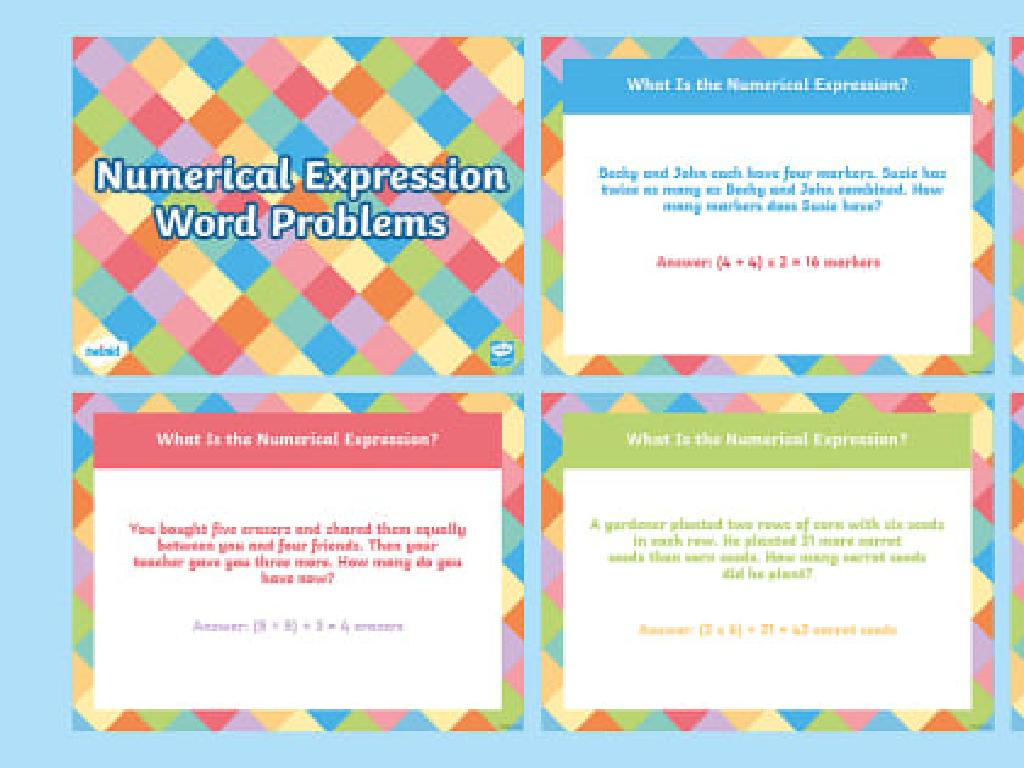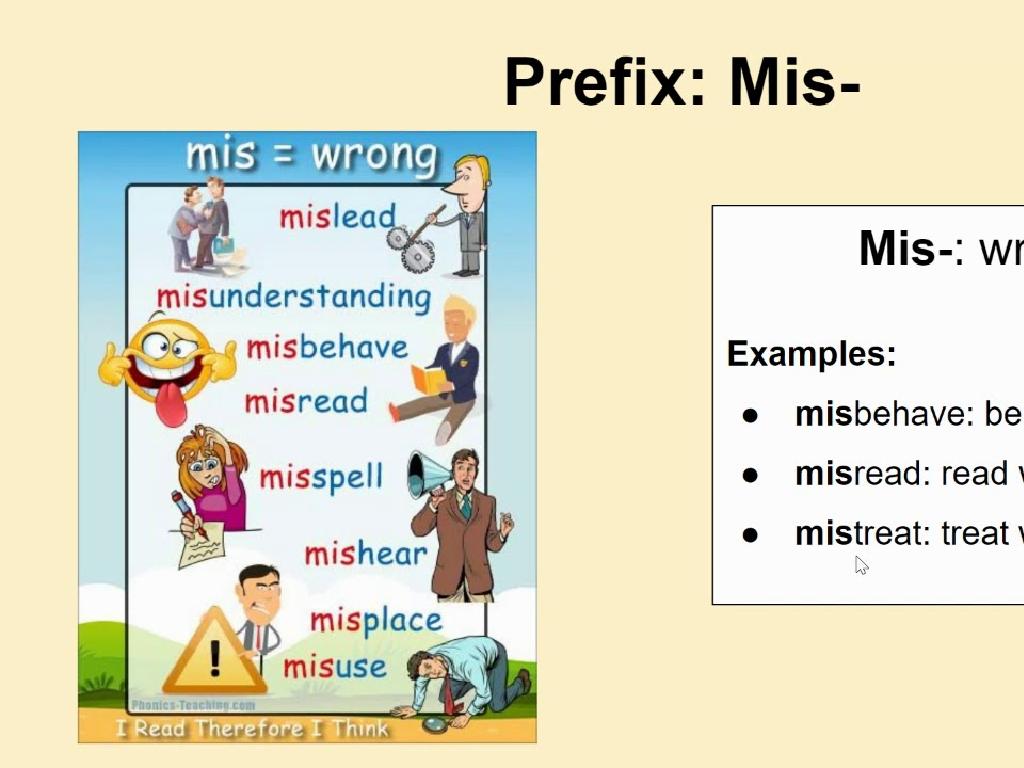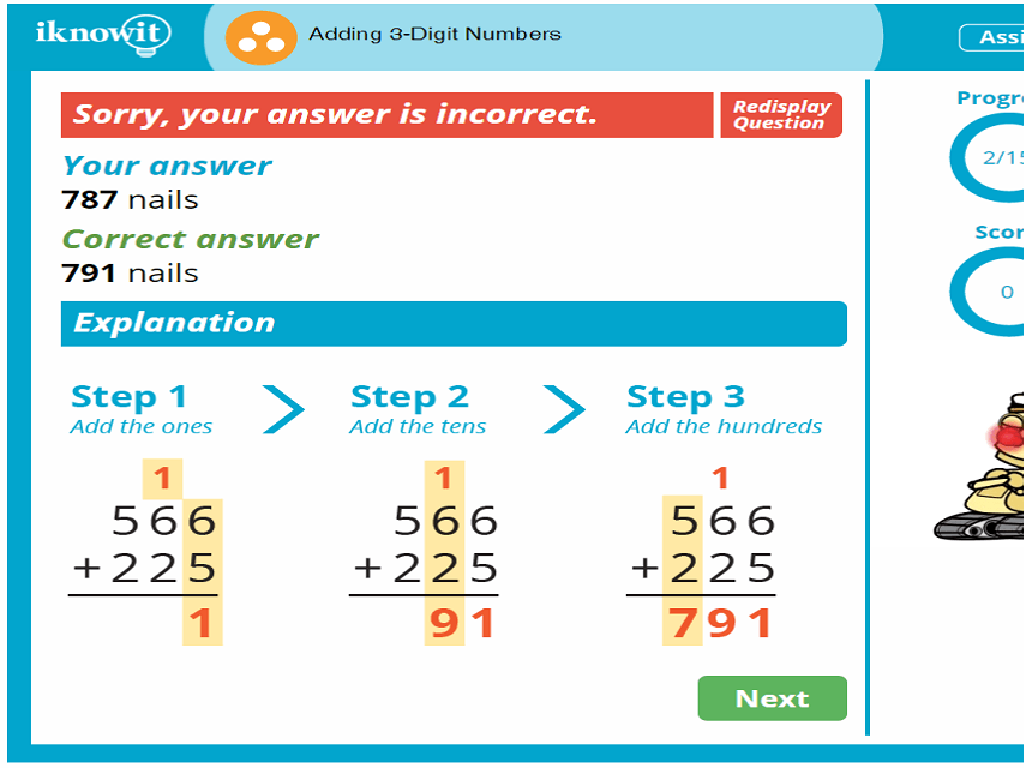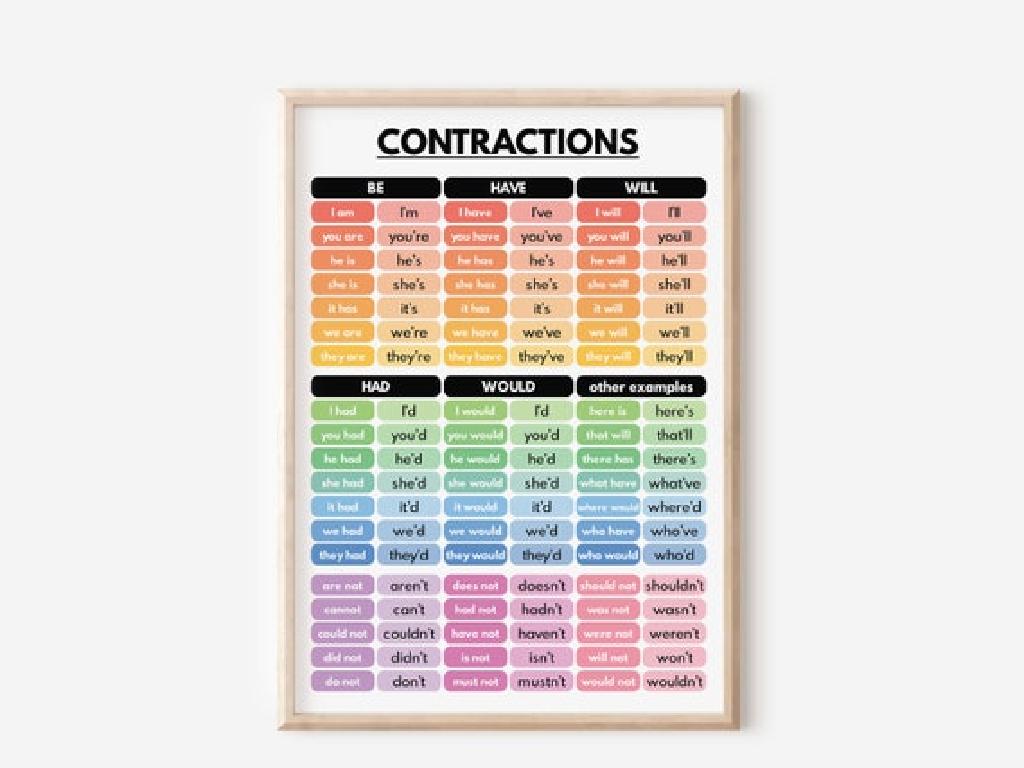Fractions Of A Group: Word Problems
Subject: Math
Grade: Fourth grade
Topic: Equivalent Fractions
Please LOG IN to download the presentation. Access is available to registered users only.
View More Content
Today’s Adventure: Fractions of a Group
– Exploring fractions with stories
– We’ll use fun tales to see fractions in action.
– Fractions in everyday life
– Think of pizza slices or sharing candies with friends.
– Solving group fraction problems
– How many slices does each person get?
– Practice with real-world examples
– Let’s figure out problems like sharing treats equally.
|
This slide introduces students to the concept of fractions in a relatable and engaging way. Start by using storytelling to illustrate fractions, making the abstract concept more concrete. Discuss how fractions appear in daily life, such as dividing a pizza among friends or sharing a bag of candies. Emphasize the practicality of understanding fractions when dealing with groups of items. Provide word problems that require students to apply their knowledge of fractions to determine how items in a group can be shared equally. Encourage students to visualize the problems with drawings or physical objects. The goal is to help students see the relevance of fractions in their lives and to build confidence in solving fraction word problems.
Understanding Fractions
– A fraction shows part of a whole
– Numerator over denominator
– Top number shows parts we have, bottom number shows total parts
– Fractions in daily life
– Pizza slices, sharing candy, measuring cups
– Practice with real examples
– How many slices of a 8-slice pizza did you eat if you had 3?
|
Begin the lesson by explaining that a fraction represents a part of a whole, something that is not complete on its own. The numerator (top number) and denominator (bottom number) are the key parts of a fraction, with the numerator indicating how many parts are being considered and the denominator indicating the total number of equal parts in the whole. Use relatable examples such as slices of pizza or sharing candy to illustrate fractions in everyday life. Encourage students to think of their own examples. Conclude with a word problem to apply their understanding of fractions in a practical context, reinforcing the concept that fractions are around us in various forms.
Understanding Equivalent Fractions
– What are equivalent fractions?
– Fractions that are different but equal, like 1/2 and 2/4.
– Finding equivalent fractions
– Multiply or divide the numerator and denominator by the same number.
– Multiplication creates equivalents
– Multiply top and bottom by 2: 1/2 becomes 2/4.
– Division creates equivalents
– Divide top and bottom by 2: 2/4 becomes 1/2.
|
This slide introduces the concept of equivalent fractions, which are fractions that have different numerators and denominators but represent the same value. Start by explaining that even though these fractions look different, they are just different ways of expressing the same part of a whole. Show how multiplying or dividing both the numerator and denominator by the same non-zero number will result in an equivalent fraction. Provide examples of multiplying to find a larger equivalent fraction and dividing to simplify or find a smaller equivalent fraction. Encourage students to practice with different numbers to become comfortable with the concept.
Fractions of a Group: Classroom Exploration
– Finding a fraction of a group
– If 2 out of 5 apples are red, the fraction is 2/5
– Real-life examples: pizza slices
– If a pizza has 8 slices and you eat 2, what fraction did you eat?
– Classroom activity: Fraction hunt
– Discuss findings with classmates
|
This slide introduces the concept of finding fractions within a group and applies it to tangible classroom examples. Start by explaining that a fraction represents parts of a whole or a group. Use relatable examples like slices of pizza to illustrate the concept. For the group activity, have students identify and count items in the classroom, then determine the fraction of the total that fits a certain category (e.g., red books out of total books). After the activity, encourage students to discuss their findings, reinforcing their understanding of fractions in a group setting. Provide guidance on how to express their findings as fractions. This interactive approach helps solidify the concept of fractions as parts of a group.
Fractions of a Group: Word Problems
– Read the problem carefully
– Understand what the question is asking
– Find the ‘whole’ and the ‘part’
– ‘Whole’ is the total amount, ‘part’ is a portion of the whole
– Solve fraction group problems
– Use fractions to figure out parts of a group
– Practice with examples
– Example: If 2/5 of the class are boys, how many are boys if there are 25 students?
|
This slide introduces students to solving word problems that involve fractions of a group. Start by guiding students to read the problem thoroughly to understand what is being asked. Next, help them identify the ‘whole’ group and the ‘part’ of the group that the problem refers to. Then, demonstrate how to use fractions to find parts of a group, such as the number of items or people. Provide practice problems similar to the example given, where students can apply these steps to solve. Encourage students to explain their reasoning and how they used the ‘whole’ and ‘part’ to find their answers.
Let’s Practice Together: Fractions Word Problems
– Step-by-step problem solving
– Example 1: We’ll solve a word problem together, breaking down each step.
– Group discussion on a new problem
– Example 2: In groups, discuss a different problem and find the solution.
– Q&A session
– Ask questions if you’re unsure and we’ll answer them together.
|
This slide is designed for an interactive class activity focused on solving word problems involving fractions. Start with a guided example, solving a word problem step by step with the class. Encourage students to participate in each step. Then, have students form small groups to discuss and solve a different problem, fostering collaborative learning. Conclude with a Q&A session, addressing any uncertainties students may have. This will help solidify their understanding of fractions in word problems. Possible activities: 1) Pair students to solve problems, 2) Use manipulatives to visualize fractions, 3) Create a word problem as a class, 4) Have students write their own problems, 5) Use a game format to make solving problems fun.
Class Activity: Fraction Scavenger Hunt
– Find classroom items as fractions
– Work in groups on word problems
– Discuss and solve problems together
– Solve problems using found items
– Use items to visualize fractions
– Share findings with the class
|
This interactive activity is designed to help students understand fractions in a tangible way. Divide the class into small groups and have them search the classroom for items that can represent fractions, such as a set of pencils where 3 out of 4 are red, representing 3/4. Then, present them with word problems that relate to the items they’ve found. For example, if a group finds 5 blue books and 10 red books, a word problem could involve finding the fraction of books that are blue. After solving the problems, each group will share their solutions and explain how they used the items to help them understand the fractions. This activity will reinforce the concept of fractions of a group and equivalent fractions, as well as promote teamwork and communication skills.
Homework: Mastering Fractions
– Practice word problems at home
– Solve problems to strengthen skills
– Get ready for the fractions quiz
– Review equivalent fractions and group fractions
– Observe fractions in daily life
– Look for fractions in cooking, shopping, etc.
– Bring questions to class
|
This slide is aimed at reinforcing the students’ understanding of fractions through practice and real-world observation. Assign additional word problems that students can work on at home to solidify their grasp of the concepts. Inform them about an upcoming quiz on equivalent fractions and fractions of a group to motivate them to review the material. Encourage them to find and think about fractions they encounter in everyday life, such as when helping in the kitchen or dividing things evenly among friends. This will help them see the relevance of what they’re learning. Remind them to bring any questions they have to the next class for clarification. Provide a variety of resources for practice, such as worksheets, online games, or interactive activities.






